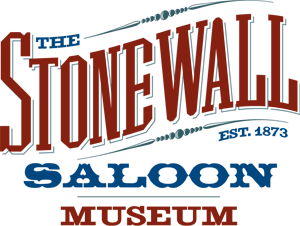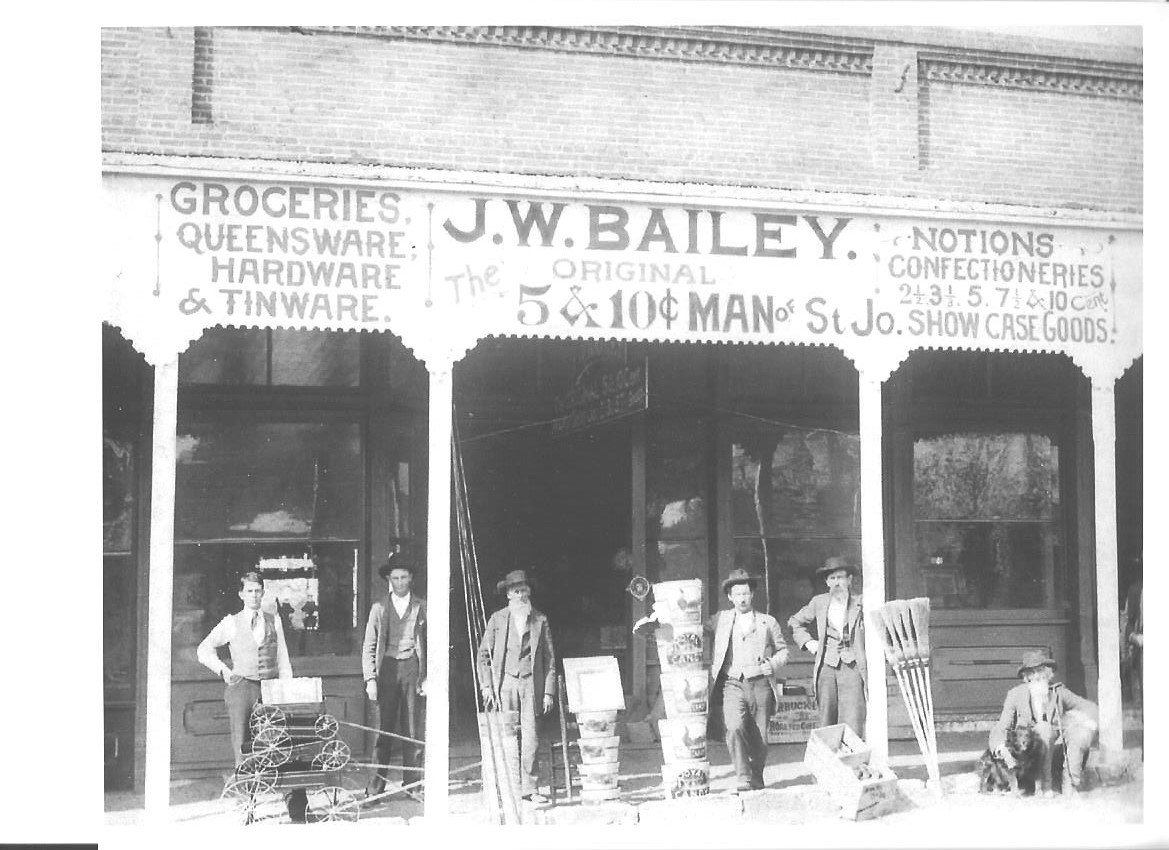History 1873-Present
The Stonewall Saloon was built in 1873 and was the first permanent building to be erected in the town built by Irby H. Boggess. The Stonewall Saloon was also the first permanent building in Montague County. The Saloon, according to stories, was opened to accommodate the thirsty trail drovers traveling on long cattle drives, headed to the Red River Station (Crossing) This trail, originally known as the Abilene Trail or Texas Trail later became known as the Chisholm Trail. David “Peg Leg” Fulton was the bartender of the Saloon. A “boarding house” was said to be upstairs. With Boggess serving as the town’s first postmaster in 1873, it is very possible the post office was located in the saloon as well. The cattle trail’s 150th anniversary was in 2017.
Cattle drive coming into Saint Jo. Notice the water tower in the background.
In 1897 came county prohibition and the closing of the saloon on February 11, 1899. The building was then used as a store, a storehouse, a restaurant and for a time Mr. Boggess used the building as his real estate office. In 1905, James R. Wiley bought the building from Boggess and established the Citizens National Bank. He took out the original bar, added a vault and modernized the front facade of the building with a large picture window. By the end of the depression, the town was no longer able to support two banks so in 1942, the owner of the competing bank, H.D. Field Sr., purchased and dissolved the Citizens Bank.
The building stayed in the Field estate and was rented for offices. For the next few years, the saloon building was used for various commercial enterprises including a doctor’s office upstairs and a real estate business. It was also the headquarters of the Kingery Brothers Oil Company for many years.
In 1950's, H.D. Field Jr., purchased the building and restored it to a replica of the original saloon. The present bar and large ornate mirrored back bar was purchased and hauled in from Floresville, Texas. They are considered to be of same era of the original bar. Swinging doors were added that sported area rancher’s brands. Families donated items to be displayed in the new museum. It opened in 1958 as the Stonewall Saloon Museum, the year of Montague County's Centennial celebration. It became a major tourist attraction and landmark for the small town. Stucco had been applied to the exterior of the building at some point in the mid-1930s.
O.K. "Kurz" Williams 1964
In 1964 the Texas Historical Survey Committee awarded a historical marker to the building. During its years as a museum Lewis Lauderdale, Lester Hendricks, Boyd Whitson, and Sue Yetter served as curators. All but Mrs. Yetter, during their tenure, lived in the back room of the saloon. The museum was sold by the Fields family in 1996 and the new owners again operated it as a replica of an old-time saloon open for occasions.
Curator Lewis Lauderdale and dog named Lady.
In February 2011, the building was purchased by locals and the property put into a 501(c3) non-profit corporation with the intent of establishing a first class museum depicting the early days of Saint Jo, Head of Elm and where the Chisholm Trail cut the California Gold Road of 1849.
Donations from within the community resulted in the ability to restore the structural integrity of the original building at a cost of just over $100,000. Time had taken its toll on the building requiring major repairs including replacing the roof, re-mortaring the stone walls, replacing the flooring, windows and interior decor. A structural engineer and a historical architect were employed for advice on the proper approach to restore the old building.
As layers of history were removed from the walls of the building, a mural was discovered. Johnny Langer, a historical art conservator from Galveston's paint conservation studio, was contacted and dated the mural to mid-1870, the first decorations on the walls. The discovered mural included urns with flowers and reeds painted on both sides of the bar. Connecting the two urns was a fringed curtain draped above the original back bar. Langer related that traveling artists commonly decorated the walls of buildings and courthouses in that era. He directed techniques to reveal the artwork, preserve it, recreate the mural, and provided advice about the original colors of the building's interior. Local artist, Joel Hale, made tracings of the artwork and recreated it after the renovation of the saloon walls was completed.
The first phase secured the integrity of the building and renovated the old saloon portion downstairs. The museum was open to visitors the first weekend in August, 2011. Visitors from multiple states and countries visited the newly opened museum. Many of the artifacts from the 1958 Centennial opening are on display as well as the majority of the items donated prior to the building being renovated.
The second phase was a two-story addition on the back of the original building. This provided the museum with double the exhibit area. The downstairs portion of the new addition opened to the public included new exhibits and ADA restrooms.
The third phase was completed in November 2017. With the completion of the entire second floor an elevator was installed, and all the additional displays were finished, including mounting the old front of the museum that had local brands and the old swinging doors on the second floor.
With the museum collection constantly growing through individual’s donations of family items, it has become a reservoir of information focusing on the area’s colorful history. With the mission being to tell the story of the Stonewall Saloon, it is hoped visitors gain a better understanding and appreciation of the life of our early pioneers, the drovers on the trail, the farmers and the businessmen; their challenges and their achievements. This is reflected through photographs, artifacts and volunteer guides. Visitors are encouraged to let us tell the story of this building which served the people of St.Jo for over 150 years.
History of the Stonewall Saloon Museum
Saint Jo, Texas A Real Trail Town















